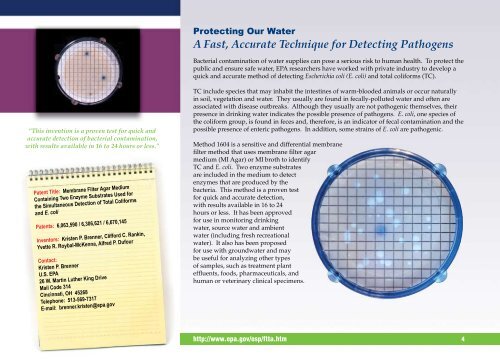FTTA Patent Catalog (PDF) - US Environmental Protection Agency
FTTA Patent Catalog (PDF) - US Environmental Protection Agency
FTTA Patent Catalog (PDF) - US Environmental Protection Agency
You also want an ePaper? Increase the reach of your titles
YUMPU automatically turns print PDFs into web optimized ePapers that Google loves.
“This invention is a proven test for quick and<br />
accurate detection of bacterial contamination,<br />
with results available in 16 to 24 hours or less.”<br />
<strong>Patent</strong> Title: Membrane Filter Agar Medium<br />
Containing Two Enzyme Substrates Used for<br />
the Simultaneous Detection of Total Coliforms<br />
and E. coli<br />
<strong>Patent</strong>s: 6,063,590 / 6,306,621 / 6,670,145<br />
Inventors: Kristen P. Brenner, Clifford C. Rankin,<br />
Yvette R. Roybal-McKenna, Alfred P. Dufour<br />
Contact:<br />
Kristen P. Brenner<br />
U.S. EPA<br />
26 W. Martin Luther King Drive<br />
Mail Code 314<br />
Cincinnati, OH 45268<br />
Telephone: 513-569-7317<br />
E-mail: brenner.kristen@epa.gov<br />
Protecting Our Water<br />
A Fast, Accurate Technique for Detecting Pathogens<br />
Bacterial contamination of water supplies can pose a serious risk to human health. To protect the<br />
public and ensure safe water, EPA researchers have worked with private industry to develop a<br />
quick and accurate method of detecting Escherichia coli (E. coli) and total coliforms (TC).<br />
TC include species that may inhabit the intestines of warm-blooded animals or occur naturally<br />
in soil, vegetation and water. They usually are found in fecally-polluted water and often are<br />
associated with disease outbreaks. Although they usually are not pathogenic themselves, their<br />
presence in drinking water indicates the possible presence of pathogens. E. coli, one species of<br />
the coliform group, is found in feces and, therefore, is an indicator of fecal contamination and the<br />
possible presence of enteric pathogens. In addition, some strains of E. coli are pathogenic.<br />
Method 1604 is a sensitive and differential membrane<br />
filter method that uses membrane filter agar<br />
medium (MI Agar) or MI broth to identify<br />
TC and E. coli. Two enzyme substrates<br />
are included in the medium to detect<br />
enzymes that are produced by the<br />
bacteria. This method is a proven test<br />
for quick and accurate detection,<br />
with results available in 16 to 24<br />
hours or less. It has been approved<br />
for use in monitoring drinking<br />
water, source water and ambient<br />
water (including fresh recreational<br />
water). It also has been proposed<br />
for use with groundwater and may<br />
be useful for analyzing other types<br />
of samples, such as treatment plant<br />
effluents, foods, pharmaceuticals, and<br />
human or veterinary clinical specimens.<br />
http://www.epa.gov/osp/ftta.htm 4

















